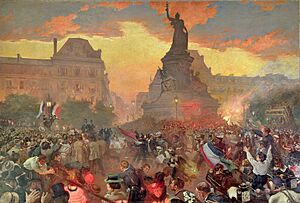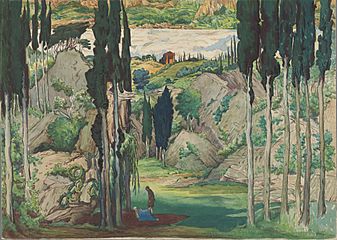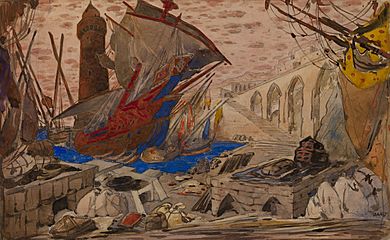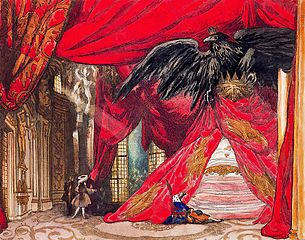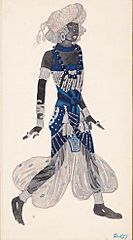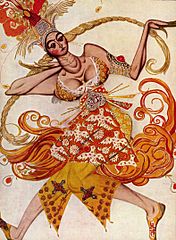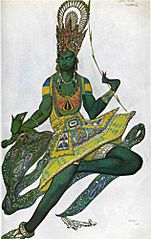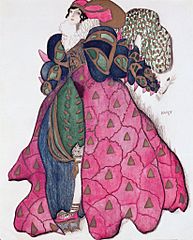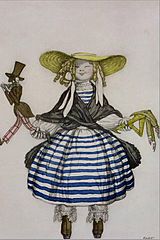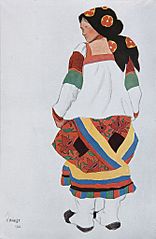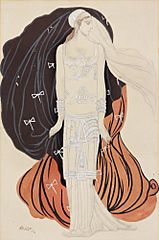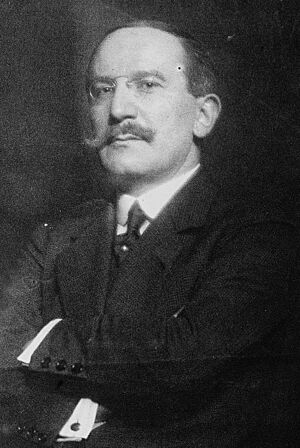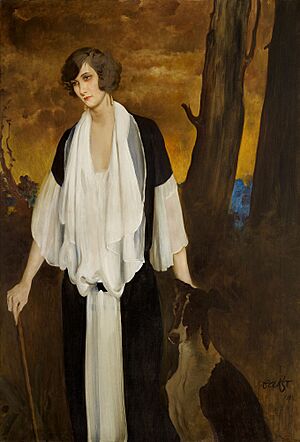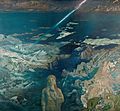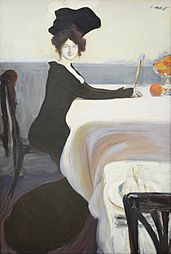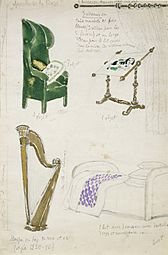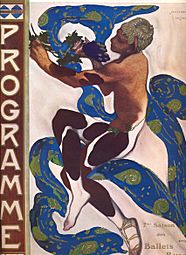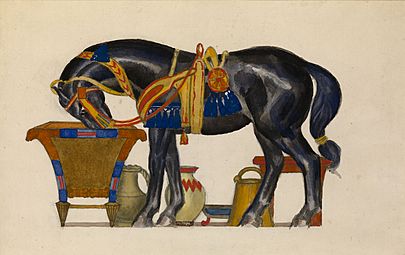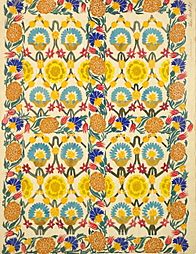Léon Bakst facts for kids
Quick facts for kids
Léon Bakst
|
|
|---|---|
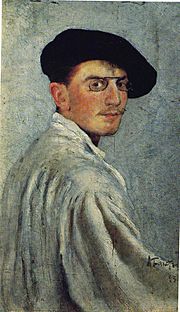
Bakst's Self-portrait, 1893, oil on cardboard, 34 × 21 cm, The State Russian Museum, St. Petersburg, Russia
|
|
| Born |
Leyb-Khaim Izrailevich Rosenberg
27 January 1866 |
| Died | 28 December 1924 (aged 58) Rueil-Malmaison, near Paris
|
| Nationality | Belarusian, Russian |
| Education | St. Petersburg Academy of Arts |
| Movement | Modernist, Orientalist themes |
Léon Bakst (Russian: Леон (Лев) Николаевич Бакст, Leon (Lev) Nikolaevich Bakst) was a famous Russian painter and a brilliant scene and costume designer. He was born as Leyb-Khaim Izrailevich Rosenberg on January 27, 1866. Bakst was a key member of the group around Sergei Diaghilev and his famous dance company, the Ballets Russes.
He was known for creating amazing, colorful sets and costumes for many ballet and theater shows. Some of his most famous designs were for Carnaval (1910), Spectre de la rose (1911), Daphnis and Chloe (1912), and The Sleeping Princess (1921). His work brought a new, exciting look to the stage.
Contents
Early Life and Artistic Beginnings
Léon Bakst, born Leyb-Khaim Izrailevich Rosenberg, grew up in Grodno in a middle-class family. His grandfather was a very skilled tailor who had a large, beautiful house in Saint Petersburg. Young Leyb loved visiting this house every Saturday. He later said that the house greatly impressed him.
When he was just twelve years old, Leyb won a drawing contest. This made him decide he wanted to be a painter. However, his parents did not approve of this idea and even threw away his paints.
A few years later, his parents divorced. Leyb and his three siblings had to find their own place to live. As the oldest, Leyb took care of his two sisters and brother. He took on "all kinds of painting work" to support them. After finishing school, he tried to get into the St. Petersburg Academy of Arts. He didn't pass the entry exam at first, so he studied there as a non-credit student. He also worked part-time illustrating books. He finally gained full admission to the Imperial Academy in 1883.
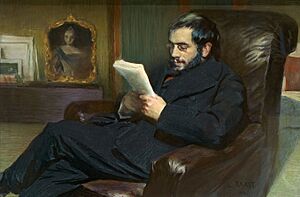
Around the time of his first art exhibition in 1889, he started using the surname Bakst. The exact reason for this name change is not fully clear. One idea is that it came from his mother's grandmother, whose maiden name was Bakster. His lifelong friend, Alexandre Benois, remembered that Bakst gave a long, confusing explanation about the name coming from distant relatives.
In the early 1890s, Bakst showed his art with the Society of Watercolourists. From 1893 to 1897, he lived in Paris, France, where he studied at the Académie Julian. He still visited Saint Petersburg often. In the mid-1890s, Bakst joined a group of writers and artists. This group included Sergei Diaghilev and Alexander Benois. In 1899, they started a very important magazine called Mir iskusstva, which means "World of Art." Bakst's drawings and designs for this magazine made him famous.
A Career in Art and Design
Bakst continued to paint portraits of famous people like Filipp Malyavin (1899) and Zinaida Gippius (1906). He also worked as an art teacher for the children of Grand Duke Vladimir Alexandrovich of Russia. In 1902, Tsar Nicholas II asked him to paint a picture of Admiral Avellan and Russian sailors arriving in Paris. Bakst started this painting in Paris in 1893, but it took him eight years to finish it.
In 1898, Bakst showed his art in the "First Exhibition of Russian and Finnish Artists," organized by Diaghilev. He also showed his work in "World of Art" exhibitions and other art shows. During the Russian Revolution of 1905, Bakst worked for several magazines, drawing pictures for publications like Zhupel and Apollon.
Starting in 1909, Bakst focused mostly on designing for the stage. He created sets for Greek plays. In 1908, he became well-known for his stage designs for Diaghilev's Ballets Russes. He designed the scenery for many famous ballets, including Cleopatra (1909), Scheherazade (1910), Carnaval (1910), Le Spectre de la Rose (1911), and Daphnis et Chloé (1912). During this time, Bakst lived in Western Europe. This was because, as a Jewish person, he was not allowed to live permanently outside a specific area in the Russian Empire called the Pale of Settlement.
- Selected stage designs
-
For Cléopâtre by Mikhail Fokine; 1910.
-
For Daphnis et Chloé by Maurice Ravel; 1912, watercolour on paper, 19 × 27 cm, Houghton Library.
-
For La Pisanelle où la Mort parfumée by Gabriele D'Annunzio; 1913, pencil, watercolour and gouache on cardboard, 24 × 39 cm, private collection.
-
The Sleeping Beauty by Pyotr Ilyich Tchaikovsky; 1921, pencil and watercolour on paper, 48 × 67 cm, Thyssen-Bornemisza Museum.
- Selected costume designs
-
For the Negro Boy in Scheherazade by Nikolai Rimsky-Korsakov; 1910.
-
For the Firebird in The Firebird; 1910.
-
For The Blue God in Le Dieu bleu by Reynaldo Hahn; 1911.
-
For Josephslegende by Hugo von Hofmannsthal and Harry Graf Kessler; 1914, private collection.
-
For the Masked Man in The Good-Humoured Ladies by Léonide Massine; 1917.
-
For the Puppet Girl in La Boutique fantasque by André Derain; 1919.
-
For Ida Rubinstein as Phaedra in Phèdre by Racine; 1923, Museum of Avant-Garde Mastery.

Even though he was famous for stage design, Bakst also created art for wealthy English families during the Art Deco period. One of his notable works from this time is the Sleeping Beauty series. He created these seven large paintings for James and Dorothy de Rothschild in 1913. These paintings decorate an oval, theater-like room at Waddesdon Manor in England.
During his visits to Saint Petersburg, Bakst taught at Zvantseva's school. One of his students was the famous artist Marc Chagall (1908–1910). Bakst considered Chagall a favorite student. He said that Chagall would listen carefully to instructions but then paint something completely different!
In 1914, Bakst was chosen as a member of the Imperial Academy of Arts. Bakst had many talents. He designed clothes, stage decorations, home interiors, and even textiles. Besides his interior designs for the Rothschilds, he also designed exhibitions for the 'Mir Iskusstva' society. He also worked as a furniture and interior designer for 'Sovremennoe Iskusstvo' (Modern Art). An American businessman, Arthur Selig, asked Bakst to create textile designs, and their collaboration was very successful.
His work was shown widely in the United States during this time. An art manager named Martin Birnbaum organized an exhibition of Bakst's work in New York City in 1913. This exhibition then traveled to other cities like Detroit, Buffalo, Cincinnati, Chicago, and Montreal.
After the Russian Revolution of 1917, Bakst's sister sadly died in Russia. When he heard the news, he became very ill and needed help from his friends. One important friend and supporter was Alice Warder Garrett (1877–1952), who helped his sister Sofia rescue him. Bakst had met Mrs. Garrett in Paris in 1914. She became a close friend and helped manage his art business in the United States.
In 1922, Bakst stopped working with Diaghilev and the Ballets Russes. That same year, he visited Baltimore, USA, and stayed at Evergreen House, the home of his friend Alice Garrett. While there, Bakst redesigned the dining room of Evergreen, making it a striking yellow and red. He also turned the house's old gymnasium into a colorful, modern private theater. This is believed to be the only private theater designed by Bakst that still exists today.
Léon Bakst was also a talented writer. He wrote novels, many articles for magazines, art reviews, essays, and letters to his friends and colleagues.
Bakst passed away on December 27, 1924, in a clinic near Paris, due to lung problems. Many famous artists, poets, musicians, dancers, and critics who admired his work joined his funeral procession. He was buried in the Cimetière des Batignolles in Paris.
In late 2010, the Victoria and Albert Museum in London held an exhibition of Bakst's costumes and prints, showing his amazing artistic legacy.
Cultural Depictions
- Anna Pavlova, a film by Emil Loteanu; Bakst was played by Igor Dmitriev (1983).
Images for kids
-
Terror Antiquus depicted destruction of Atlantis, Lion Gate of Mycenae, Tiryns and Acropolis of Athens, with Kore presiding over to symbolize chaos and inevitability of human force; 1908, oil on canvas, 250 × 270 cm, Russian Museum.
Selected Works
-
Stage furniture design for Le Spectre de la rose by Michel Fokine; c. 1911.
- ''The Sleeping Beauty'' series; 1913–22, oil on canvas, Waddesdon Manor
See also
 In Spanish: Léon Bakst para niños
In Spanish: Léon Bakst para niños
- List of Orientalist artists
- Orientalism
- Place des États-Unis


